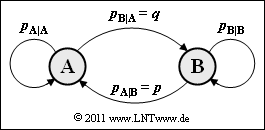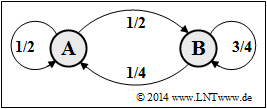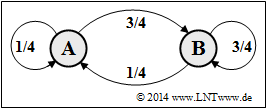Difference between revisions of "Aufgaben:Exercise 1.5: Binary Markov Source"
| Line 1: | Line 1: | ||
| − | {{quiz-Header|Buchseite= | + | {{quiz-Header|Buchseite=Information_Theory/Discrete_Sources_with_Memory |
}} | }} | ||
Latest revision as of 13:03, 10 August 2021
Exercise 1.4 has shown that the calculation of the entropy for a source with memory can be very time-consuming. One must then first calculate (very many) entropy approximations $H_k$ for $k$–tuples and only then the source entropy can be determined with the boundary transition $k \to \infty$ :
- $$H = \lim_{k \rightarrow \infty } H_k \hspace{0.05cm}.$$
Often, $H_k$ tends only very slowly towards the limit $H$.
The calculation process is drastically reduced if the message source has Markov properties. The graphic shows the transition diagram for a binary Markov source with the two states (symbols) $\rm A$ and $\rm B$.
- This is clearly determined by the two conditional probabilities $p_{\rm A\hspace{0.01cm}|\hspace{0.01cm}B} = p$ and $p_{\rm B\hspace{0.01cm}|\hspace{0.01cm}A} = q$ .
- The other conditional probabilities $p_{\rm A\hspace{0.01cm}|\hspace{0.01cm}A}$ and $p_{\rm B\hspace{0.01cm}|\hspace{0.01cm}B}$ as well as the (unconditional) symbol probabilities $p_{\rm A}$ and $p_{\rm B}$ can be determined from this.
The entropy of the binary Markov chain (with the unit "bit/symbol") is then:
- $$H = H_{\rm M} = p_{\rm AA} \cdot {\rm log}_2\hspace{0.1cm}\frac {1}{ p_{\rm A\hspace{0.01cm}|\hspace{0.01cm}A}} + p_{\rm AB} \cdot {\rm log}_2\hspace{0.1cm}\frac {1}{ p_{\rm B\hspace{0.01cm}|\hspace{0.01cm}A}} + p_{\rm BA} \cdot {\rm log}_2\hspace{0.1cm}\frac {1}{ p_{\rm A\hspace{0.01cm}|\hspace{0.01cm}B}} + p_{\rm BB} \cdot {\rm log}_2\hspace{0.1cm}\frac {1}{ p_{\rm B\hspace{0.01cm}|\hspace{0.01cm}B}} \hspace{0.05cm}.$$
It should be noted that in the argument of the "binary logarithm", the conditional probabilities $p_{\rm A\hspace{0.01cm}|\hspace{0.01cm}A}$, $p_{\rm B\hspace{0.01cm}|\hspace{0.01cm}A}$, ... are to be used, while the "Conditional Probabilities" $p_{\rm AA}$, $p_{\rm AB}$, ... are to be used for the weighting.
Using the first order entropy approximation,
- $$H_1 = p_{\rm A} \cdot {\rm log}_2\hspace{0.1cm}\frac {1}{ p_{\rm A}} + p_{\rm B} \cdot {\rm log}_2\hspace{0.1cm}\frac {1}{ p_{\rm B}} \hspace{0.5cm}({\rm unit\hspace{-0.1cm}: \hspace{0.1cm}bit/symbol})\hspace{0.05cm},$$
as well as the (actual) entropy $H = H_{\rm M}$ given above, all further entropy approximations $(k = 2, 3, \text{...})$ can also be given directly for a Markov source:
- $$H_k = \frac{1}{k} \cdot \big [ H_{\rm 1} + (k-1) \cdot H_{\rm M} \big ] \hspace{0.05cm}.$$
Hints:
- The exercise belongs to the chapter Discrete Sources with Memory.
- Reference is also made in particular to the two pages "Intersection" and "Conditional Probability".
- With the exception of subtask (6) $p = 1/4$ and $q = 1/2$ always apply.
- For the (ergodic) symbol probabilities of a first order Markov chain applies:
- $$ p_{\rm A} = \frac {p_{\rm A\hspace{0.01cm}|\hspace{0.01cm}B}} { p_{\rm A\hspace{0.01cm}|\hspace{0.01cm}B} + p_{\rm B\hspace{0.01cm}|\hspace{0.01cm}A}} \hspace{0.05cm}, \hspace{0.3cm} p_{\rm B} = \frac {p_{\rm B\hspace{0.01cm}|\hspace{0.01cm}A}} { p_{\rm A\hspace{0.01cm}|\hspace{0.01cm}B} + p_{\rm B\hspace{0.01cm}|\hspace{0.01cm}A}} \hspace{0.05cm}.$$
Questions
Solution
After $\rm A$ , $\rm A$ and $\rm B$ are equally probable. After $\rm B$ , $\rm B$ occurs much more frequently than $\rm A$ . The following applies to the transition probabilities
- $$p_{\rm A\hspace{0.01cm}|\hspace{0.01cm}A} \hspace{0.1cm} = \hspace{0.1cm} 1 - p_{\rm B\hspace{0.01cm}|\hspace{0.01cm}A}= 1 - q \hspace{0.15cm} \underline {= 0.5} \hspace{0.05cm},$$
- $$ p_{\rm B\hspace{0.01cm}|\hspace{0.01cm}B} \hspace{0.1cm} = \hspace{0.1cm} 1 - p_{\rm A\hspace{0.01cm}|\hspace{0.01cm}B}= 1 - p \hspace{0.15cm} \underline {= 0.75} \hspace{0.05cm}.$$
(2) According to the equations given:
- $$p_{\rm A}= \frac{p}{p+q} = \frac{0.25}{0.25 + 0.50} \hspace{0.15cm} \underline {= 0.333} \hspace{0.05cm}, \hspace{0.5cm} p_{\rm B} = \frac{q}{p+q} = \frac{0.50}{0.25 + 0.50} \hspace{0.15cm} \underline {= 0.667} \hspace{0.05cm}.$$
(3) With the probabilities calculated in the last sub-task:
- $$H_{\rm 1} = H_{\rm bin}(p_{\rm A}) = 1/3 \cdot {\rm log}_2\hspace{0.01cm} (3) + 2/3 \cdot {\rm log}_2\hspace{0.01cm} (1.5) = 1.585 - 2/3\hspace{0.15cm} \underline {= 0.918 \,{\rm bit/symbol}} \hspace{0.05cm}.$$
(4) The entropy of the Markov source is according to:
- $$H = p_{\rm AA} \cdot {\rm log}_2\hspace{0.1cm}\frac {1}{ p_{\rm A\hspace{0.01cm}|\hspace{0.01cm}A}} + p_{\rm AB} \cdot {\rm log}_2\hspace{0.1cm}\frac {1}{ p_{\rm B\hspace{0.01cm}|\hspace{0.01cm}A}} + p_{\rm BA} \cdot {\rm log}_2\hspace{0.1cm}\frac {1}{ p_{\rm A\hspace{0.01cm}|\hspace{0.01cm}B}} + p_{\rm BB} \cdot {\rm log}_2\hspace{0.1cm}\frac {1}{ p_{\rm B\hspace{0.01cm}|\hspace{0.01cm}B}} \hspace{0.05cm}.$$
- For the composite probabilities holds:
- $$p_{\rm AA} = p_{\rm A\hspace{0.01cm}|\hspace{0.01cm}A} \cdot p_{\rm A} = (1-q) \cdot \frac{p}{p+q} = \frac{1/2 \cdot 1/4}{3/4} = {1}/{6} \hspace{0.05cm},$$
- $$ p_{\rm AB} = p_{\rm B\hspace{0.01cm}|\hspace{0.01cm}A} \cdot p_{\rm A} = q \cdot \frac{p}{p+q} = \frac{1/2 \cdot 1/4}{3/4} = {1}/{6} \hspace{0.05cm},$$
- $$ p_{\rm BA} = p_{\rm A\hspace{0.01cm}|\hspace{0.01cm}B} \cdot p_{\rm B} = p \cdot \frac{q}{p+q} = p_{\rm AB} = {1}/{6} \hspace{0.05cm},$$
- $$ p_{\rm BB} = p_{\rm B\hspace{0.01cm}|\hspace{0.01cm}B} \cdot p_{\rm B} = (1-p) \cdot \frac{q}{p+q} = \frac{3/4 \cdot 1/2}{3/4} = {1}/{2} $$
- $$\Rightarrow\hspace{0.3cm} H = 1/6 \cdot {\rm log}_2\hspace{0.01cm} (2) + 1/6 \cdot {\rm log}_2\hspace{0.01cm} (2) + 1/6 \cdot {\rm log}_2\hspace{0.01cm} (4) + 1/2 \cdot {\rm log}_2\hspace{0.1cm} (4/3) = 10/6 - 1/2 \cdot {\rm log}_2\hspace{0.01cm} (3) \hspace{0.15cm} \underline {= 0.875 \,{\rm bit/symbol}} \hspace{0.05cm}.$$
(5) In general, with $H_{\rm M} = H$ for $k$–th entropy approximation:
- $$H_k = {1}/{k} \cdot [ H_{\rm 1} + (k-1) \cdot H_{\rm M}] \hspace{0.05cm}.$$
- It follows that:
- $$H_2 = {1}/{2} \cdot [ 0.918 + 1 \cdot 0.875] \hspace{0.15cm} \underline {= 0.897 \,{\rm bit/symbol}} \hspace{0.05cm},$$
- $$ H_3 = {1}/{3} \cdot [ 0.918 + 2 \cdot 0.875] \hspace{0.15cm} \underline {= 0.889 \,{\rm bit/symbol}} \hspace{0.05cm},$$
- $$ H_4 = {1}/{4} \cdot [ 0.918 + 3 \cdot 0.875] \hspace{0.15cm} \underline {= 0.886 \,{\rm bit/symbol}} \hspace{0.05cm}.$$
(6) With the new set of parameters $(p = 1/4, q = 3/4)$, we obtain for the symbol probabilities:
- $$ p_{\rm A} = 1/4, \ p_{\rm B} = 3/4.$$
- This special case thus leads to statistically independent symbols:
- $$ p_{\rm A} = p_{\rm A\hspace{0.01cm}|\hspace{0.01cm}A} = p_{\rm A\hspace{0.01cm}|\hspace{0.01cm}B} \hspace{0.05cm}, \hspace{0.2cm} p_{\rm B} = p_{\rm B\hspace{0.01cm}|\hspace{0.01cm}A} = p_{\rm B\hspace{0.01cm}|\hspace{0.01cm}B} \hspace{0.05cm}.$$
- Thus the entropy $H$ is identical with the entropy approximation $H_1$:
- $$H = H_{\rm 1} = 1/4 \cdot {\rm log}_2\hspace{0.01cm} (4) + 3/4 \cdot {\rm log}_2\hspace{0.01cm} (4/3) = 2 - 0.75 \cdot {\rm log}_2\hspace{0.01cm} (3) \hspace{0.15cm} \underline {= 0.811 \,{\rm bit/Symbol}} \hspace{0.05cm}.$$
- The entropy approximations $H_2$, $H_3$, $H_4$, ... also yield the result $0.811 \, \rm bit/symbol$.


